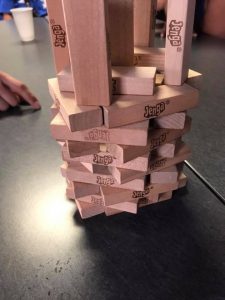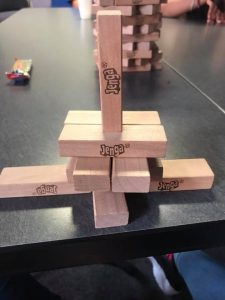It’s difficult to believe that I am coming to the end of my time at Erie House. In the few weeks I have been here, I have learned a multitude of skills, listened to new perspectives on life, and saw the service sector function through a different organization. Each day was another day to learn, to grow, to challenge myself. Yet, some days brought lessons that were seemingly more profound than others and introduced me to a new way of viewing relationship-building, and life in general.
Since ninety-eight percent of my work has been with elementary-age or middle-school age kids, I’ve definitely become more apt at playing sports as well as a variety of board games that I had either not touched since my own childhood or have never seen in general. However, Jenga was one of the games that I was quite familiar with (as there was the “giant version” Jenga in the game room at Valpo). One night at one of the youth programming events, we played Jenga—but with a twist.
In this game, Solomon, the man in charge of the youth programming (youth being anyone from 7th-10th grade) at Erie House, gave us eight blocks each. With those eight blocks, we were supposed to build whatever we wanted. Not understanding the ulterior motive (there always is one—or so I believed), I began constructing a tower that would be quite stable if a block were removed (I tried to anticipate what he could possibly be doing and figured it would be safe to go with a short and stable tower). But what came next surprised me. He had his own eight blocks but he didn’t build anything. Instead, he asked me if he could put a block on my tower. I looked suspiciously at him but added a ninth piece to my already amazing-eight-piece tower. But I wasn’t the only one. He went around to each youth and asked to put a block on their tower. Some decided to take it, others did not.
At the end, we had to share why we built the tower the way we did. Some youth explained that they wanted to build the tallest tower, and so they had paired up with one of the staff members or each other to create a taller tower. Others made shapes, like a duck, and said they did it for fun. It was neat to see the level of creativity and the amusing replies they gave. But then Solomon then asked if any of us had any idea what the point of the game was. We all went around and shared our thoughts. Some people believed it was about teamwork since many of them decided to put their blocks together to make something bigger, others believed it to be about individual creativity.
Solomon stood up and pointed at each tower and asked if we could identify which blocks were ours if we had joined our blocks together. Some said yes. Others no. Then it became clearer as he explained.
“This whole exercise was about creating a narrative. We all have our own stories, but sometimes we don’t know what story we want to tell, so we hop on someone else’s and create a narrative that way.
Do you remember that I asked each one of you if I could add a block to your tower? Some of you said ‘yes’, and others of you didn’t. That was me asking to be a part of your story, of your narrative. It’s okay if you said no. Sometimes you see something you really want to be a part of and sometimes you’ll get turned away. But it’s okay, because there might be openings other places to insert yourself and be a part of that story. With each tower, you created a story, a narrative—by yourself or with others. But in the end, this is about understanding how we all relate to each other, and the ability to accept or decline people to be a part of our story and making it our own.”
It was amazing how something so simple like Jenga could become so profound. This extends past just talking about youth programming. It’s about life. We are all building Jenga block towers, so precariously stacked and with only so many pieces, but we don’t always have to build it alone. We can if we want to and that’s acceptable. We can also allow others to help us create what is our own story and account of our lives, actions, and character.
This metaphor isn’t just for the youth at Erie House, but for each person who is telling his/her/their story in life. As I move forward, soon to end my time at Erie House, I’ll know that my metaphorical Jenga tower is even broader because of all the blocks I allowed to be added to my narrative. I hope that I was also able to take some of my Jenga blocks and add them to the youth and staff I worked with in the short time I was there. However, as I continue on to Spain where I’ll be teaching next year, I hope to use this metaphor, this story and its meaning, to better form relationships and deeply reflect and think about what it means to be an individual and collective in creating personal stories.


Very interesting post! It is a very interesting activity for children.